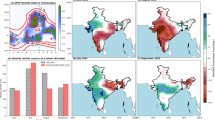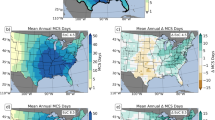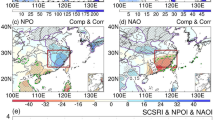Abstract
In the present research we explored the variability of convective available potential energy (CAPE) during wet and dry spells over southeast India. Comparison between India Meteorological Department (IMD) observations and reanalysis products (NCEP, ERA-interim, and MERRA) reconfirms that gridded data sets can be utilized to fill the void of observations. Later, GPS radiosonde measurements made at Gadanki (13.5 N, 79.2 E) Andre analysis output are utilized to address key scientific issues related to CAPE over the southeastern peninsular region. They are: (1) How does CAPE vary between different spells of the Indian summer monsoon (i.e., from wet to dry spell)? (2) Does differences in CAPE and in the vertical structure of buoyancy between spells are localized features over Gadanki or observed all over southeastern peninsular region? (3) What physical/dynamical processes are responsible for the differences in CAPE between spells and how do they affect the convection growth in dry spell? Interestingly, CAPE is higher in wet spell than in dry spell, in contrast to the observations made elsewhere over land and warm oceans. Similar feature (high CAPE in wet spell) is observed at all grid points in the southeastern peninsular India. Furthermore, vertical buoyancy profiles show only one peak in the middle–upper troposphere in wet spell, while two peaks are observed in most of the profiles (66%) in dry spell over the entire study region in all the reanalysis products. Plausible mechanisms are discussed for the observed CAPE differences. They are, among others, timing of sounding with reference to rain occurrence, rapid buildup of surface instabilities, moistening of lower troposphere by evaporation of the surface moisture in wet spell, enhanced low-level moisture convergence, evaporation of rain in relatively warm and dry atmosphere, and reduction of positive buoyancy in dry spell. The omnipresence of stable layers and strong and deep shear in the presence of weak updrafts (buoyancy) limits the growth of convective draft cores in dry spell.








Similar content being viewed by others
References
Alapattu PD, Kunnikrishnan KP (2009) Premonsoon estimates of convective available potential energy over the oceanic region surrounding the Indian subcontinent. J Geophys Res 114(D08108):11. https://doi.org/10.1029/2008JD011521
Bhat GS et al (2001) BOBMEX: the Bay of Bengal monsoon experiment. Bull Am Meteorol Soc 82:2217–2243
Bhowmik Roy SK, Roy SS, Kundu PK (2008) Analysis of large scale conditions associated with convection over Indian monsoon region. Int J Climatol 28:797–821
Cifelli R, Rutledge SA (1998) Vertical motion, diabatic heating, and rainfall characteristics in N. Australia convective systems. Q J R Meteorol Soc 124:1133–1162
Dee DP, Uppala SM, Simmons AJ, Berrisford P, Poli P, Kobayashi S, Andrae U, Balmaseda MA, Balsamo G, Bauer P, Bechtold P, Beljaars ACM, van de Berg L, Bidlot J, Bormann N, Delsol C, Dragani R, Fuentes M, Geer AJ, Haimberger L, Healy SB, Hersbach H, Hólm EV, Isaksen L, Kållberg P, Köhler M, Matricardi M, McNally AP, Monge-Sanz BM, Morcrette J-J, Park B-K, Peubey C, de Rosnay P, Tavolato C, Thépaut J-N, Vitart F (2011) The ERA-Interim reanalysis: configuration and performance of the data assimilation system. Quarterly Journal of the Royal Meteorological Society 137(656):553–597
DeMott AC, Randall DA (2004) Observed variations of tropical convective available potential energy. J Geophys Res 109:D02102. https://doi.org/10.1029/2003JD003784
Emanuel KA (1994) Atmospheric convection. Oxford University Press, New York, p 580
Gadgil S, Joseph PV (2003) On the breaks of the Indian monsoon. Proc Indian Acad Sci (Earth Planet Sci) 112:529–558
Gettelman A, Seidel DJ, Wheeler MC, Ross RJ (2002) Multidecadal trends in tropical convective available potential energy. J Geophys Res 107(D21):4606. https://doi.org/10.1029/2001JD001082
Goswami BN, Venugopal V, Sengupta D, Madhusoodanan MS, Xavier PK (2006) Increasing trend of extreme rain events over India in a warming environment. Science 314:1442–1445
Goswami BB, Mukhopadhyay P, Mahanta R, Goswami BN (2010) Multiscale interaction with topography and extreme rainfall events in the northeast Indian region. J Geophys Res 115:D12114. https://doi.org/10.1029/2009JD012275
Kalney E et al (1996) The NCEP-NCAR 40-year reanalysis project. Bull Am Meteorol Soc 77:437–471
Keenan TD, Carbone RE (2006) A preliminary morphology of precipitation systems in northern Australia. Q J R Meteorol Soc 118:283–326
Mani NJ, Suhas E, Goswami BN (2009) Can global warming make Indian monsoon weather less predictable? Geophys Res Lett 36:L08811. https://doi.org/10.1029/2009GL037989
Mapes BE, Houze RA Jr (1992) An integrated view of the 1987 Australian monsoon and its mesoscale convective systems. Part I: Horizontal structure. Q J R Meteorol Soc 118:927–963
McBride JL, Frank WM (1999) Relationships between stability and monsoon convection. J Atmos Sci 56:24–36
Mohan TS, Rao TN (2012) Variability of the thermal structure of the atmosphere during wet and dry spells over southeast India and its implication on draft cores. Q J R Meteorol Soc 138:1839–1851
Murthy BS, Sivaramakrishnan S (2006) Moist convective instability over the Arabian Sea during the Asian summer monsoon 2002. Meteorol Appl 13:63–72
Rajeevan M, Bhate J, Kale JD, Lal B (2006) High resolution daily gridded rainfall data for the Indian region: analysis of break and active monsoon spells. Curr Sci 91:296–306
Ramamurthy K (1969) Monsoon of India: Some aspects of the ‘break’ in the Indian southwest monsoon during July and August. Forecasting Manual 1–57 No. IV 18.3; India Met. Dept., Poona, India
Rao TN, Uma KN, Satyanarayana TM, Rao DN (2009) Differences in draft core statistics from wet spell to dry spell over Gadanki (13.5° N, 79.2° E), India. Mon Weather Rev 137:4293–4306
Rienecker MM, Suarez MJ, Gelaro R, Todling R, Bacmeister J, Liu E, Bosilovich MG, Schubert SD, Takacs L, Kim G.-K, Bloom S, Chen J, Collins D, Conaty A, da Silva A (2011) MERRA: NASA's Modern-Era Retrospective Analysis for Research and Applications. J Climate 24:3624–3648. https://doi.org/10.1175/JCLI-D-11-00015.1
Singh D, Tsiang M, Rajaratnam B, Diffenbaugh SN (2014) Observed changes in extreme wet and dry spells during the South Asian summer monsoon season. Nat Clim Change 4:456–461
Webster PJ, Holland GJ, Curry JA, Chang H-R (2005) Changes in the tropical cyclone number, duration, and intensity in a warming environment. Science 309:1844–1846
Weisman ML, Rotunno R (2004) “A theory for strong long-lived squall lines” revisited. J Atmos Sci 61:361–382
Williams E, Renno N (1993) An analysis of conditional instability of the tropical atmosphere. Mon Weather Rev 121:21–36
Williams E et al (2002) Contrasting convective regimes over the Amazon: implications for cloud electrification. J Geophys Res 107:8082–8101
Xu K, Emanuel KA (1989) Is the tropical atmosphere conditionally unstable?. Mon Wea Rev 117:1471–1479
Ye B, Del Genio AD, Lo KK-W (1998) CAPE variation in the current climate and in a climate change. J Clim 11:1997–2015
Acknowledgements
Authors sincerely acknowledge Director, National Atmospheric Research Laboratory, Gadanki, Government of India for providing the necessary facilities to carry out the research work. They also thank the anonymous reviewers for providing valuable comments and suggestions for the significant improvement of the manuscript.
Author information
Authors and Affiliations
Corresponding author
Additional information
Responsible Editor: A.-P. Dimri.
Rights and permissions
About this article
Cite this article
Mohan, T.S., Rao, T.N. & Rajeevan, M. Differences in CAPE between wet and dry spells of the monsoon over the southeastern peninsular India. Meteorol Atmos Phys 131, 657–668 (2019). https://doi.org/10.1007/s00703-018-0590-9
Received:
Accepted:
Published:
Issue Date:
DOI: https://doi.org/10.1007/s00703-018-0590-9




